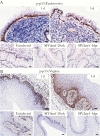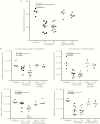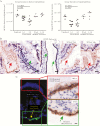Vaccine-Associated Maintenance of Epithelial Integrity Correlated With Protection Against Virus Entry
- PMID: 29401315
- PMCID: PMC6455945
- DOI: 10.1093/infdis/jiy062
Vaccine-Associated Maintenance of Epithelial Integrity Correlated With Protection Against Virus Entry
Abstract
To identify the mechanisms by which human immunodeficiency virus type 1 (HIV-1) might penetrate the epithelial barrier during sexual transmission to women and the mechanisms of vaccine-associated protection against entry, we characterized early epithelial responses to vaginal inoculation of simian immunodeficiency virus strain mac251 (SIVmac251) in naive or SIVmac239Δnef-vaccinated rhesus macaques. Vaginal inoculation induced an early stress response in the cervicovaginal epithelium, which was associated with impaired epithelial integrity, damaged barrier function, and virus and bacterial translocation. In vaccinated animals, early stress responses were suppressed, and the maintenance of epithelial barrier integrity correlated with prevention of virus entry. These vaccine-protective effects were associated with a previously described mucosal system for locally producing and concentrating trimeric gp41 antibodies at the mucosal interface and with formation of SIV-specific immune complexes that block the stress responses via binding to the epithelial receptor FCGR2B and subsequent inhibitory signaling. Thus, blocking virus entry may be one protective mechanism by which locally concentrated non-neutralizing Ab might prevent HIV sexual transmission to women.
Figures







Similar articles
-
Temporal analyses of virus replication, immune responses, and efficacy in rhesus macaques immunized with a live, attenuated simian immunodeficiency virus vaccine.J Virol. 1998 Sep;72(9):7501-9. doi: 10.1128/JVI.72.9.7501-7509.1998. J Virol. 1998. PMID: 9696847 Free PMC article.
-
ALVAC-SIV-gag-pol-env-based vaccination and macaque major histocompatibility complex class I (A*01) delay simian immunodeficiency virus SIVmac-induced immunodeficiency.J Virol. 2002 Jan;76(1):292-302. doi: 10.1128/jvi.76.1.292-302.2002. J Virol. 2002. PMID: 11739694 Free PMC article.
-
Live simian immunodeficiency virus vaccine correlate of protection: immune complex-inhibitory Fc receptor interactions that reduce target cell availability.J Immunol. 2014 Sep 15;193(6):3126-33. doi: 10.4049/jimmunol.1400822. Epub 2014 Aug 20. J Immunol. 2014. PMID: 25143442 Free PMC article.
-
Vaccine-modified NF-kB and GR signaling in cervicovaginal epithelium correlates with protection.Mucosal Immunol. 2018 Mar;11(2):512-522. doi: 10.1038/mi.2017.69. Epub 2017 Aug 9. Mucosal Immunol. 2018. PMID: 28792003 Free PMC article.
-
Antiviral CD8+ T cells in the genital tract control viral replication and delay progression to AIDS after vaginal SIV challenge in rhesus macaques immunized with virulence attenuated SHIV 89.6.J Intern Med. 2009 Jan;265(1):67-77. doi: 10.1111/j.1365-2796.2008.02051.x. J Intern Med. 2009. PMID: 19093961 Free PMC article. Review.
Cited by
-
High-Resolution Quantitative Mapping of Macaque Cervicovaginal Epithelial Thickness: Implications for Mucosal Vaccine Delivery.Front Immunol. 2021 Jun 28;12:660524. doi: 10.3389/fimmu.2021.660524. eCollection 2021. Front Immunol. 2021. PMID: 34262561 Free PMC article.
References
-
- UN Joint Programme on HIV/AIDS (UNAIDS). Global Report: UNAIDS Report on the Global AIDS Epidemic. Geneva, Switzerland: UNAIDS, World Health Organization; 2014.
-
- Fauci AS. 25 years of HIV. Nature 2008; 453:289–90. - PubMed
-
- UN Joint Programme on HIV/AIDS (UNAIDS). Global Report: UNAIDS Report on the Global AIDS Epidemic. Geneva, Switzerland: UNAIDS, World Health Organization; 2013.
-
- Morison L. The global epidemiology of HIV/AIDS. Br Med Bull 2001; 58:7–18. - PubMed
-
- Quinn TC, Overbaugh J. HIV/AIDS in women: an expanding epidemic. Science 2005; 308:1582–3. - PubMed
Publication types
MeSH terms
Substances
Grants and funding
LinkOut - more resources
Full Text Sources
Other Literature Sources
Miscellaneous

